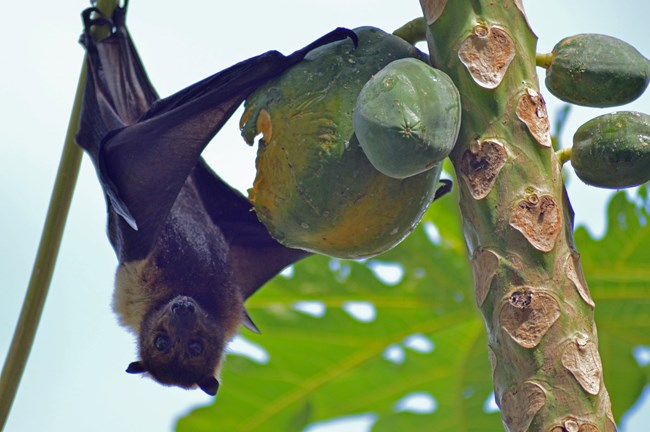Sure, it's interesting that bats navigate by echolocation and that they're nocturnal. But do they really matter? The short answer is "Yes!" These flying mammals bring many benefits to their ecosystems. More than 50 unique species of bats live in national parks, and different species provide different benefits. Some pollinate plants, others eat insects, many serve as prey to other animals, and they all inspire scientific discoveries.

NPS Photo
Some Bats are Pollinators
Several species of bats in tropical and subtropical areas of the Americas eat nectar. Many types of plants in these regions rely on bats for pollination and seed dispersal, such as the blue agave. In some southwestern parks, long-nose and long-tongue bats are perfectly adapted to pollinate these plants, and they provide extensive value to the agricultural industry. So next time you sweeten your coffee with agave nectar, remember to thank a bat.Bat Guano Supports Cave Communities
Caves are complex and unique ecosystems that provide homes for a diversity of creatures from insects to amphibians and fish as well as mammals like wood rats and bats. Many of these creatures can only survive within the cave, and they rely on nutrients carried into the cave by water or other animals. Bats benefit caves by providing important nutrients in their guano (better fertilizer than cow manure!) that support the growth of communities of cave organisms.
Image courtesy of Merlin Tuttle / Bat Conservation International
Some Bats Provide Insect Control
Bats that eat insects are called "insectivorous." They feast on insects each night, adding up to more than $3.7 billion worth of pest control each year in the U.S. When bats are around to eat insects, there are fewer insect pests causing damage to crops, and farmers don't have to invest as much in pesticides. Bats can eat 50% or more of their bodyweight in insects each night. Imagine eating 200 quarter-pound burgers—that's how much a bat eats in insects in one night!Bats Are Also Prey
Just as some bats rely on thousands of insects each night for survival, other animals in the ecosystem rely on bats for their calories. Hawks, falcons, and owls eat bats, and mammals like weasels, ringtail cats, and raccoons sometimes attack bats while they roost.
Photo courtesy of Lyn Alexander
Fruit-Eating Bats Disperse Seeds
Fruit-eating bats play important roles in distributing seeds to maintain plants and forests. These species of bats, often called "flying foxes" because of their larger body size and big eyes, live in tropical and subtropical areas of the Old World (Africa, Asia and Australia). Fruit-eating bats are also found in some Pacific islands, Latin America, and the Caribbean and live in national parks in Guam, American Samoa, and the Virgin Islands!Bats Provide Inspiration
Some of bats' unique features like membrane wings and echolocation have inspired technological advances in engineering. Drones that have thin and flexible bat-like wings are are in the works as well as tiny, more efficient sonar systems for navigation. The wingsuits used by basejumpers take more than a few cues from bats' aerodynamic bodies.Need more reasons?
20 Reasons to Appreciate BatsLast updated: November 18, 2025
